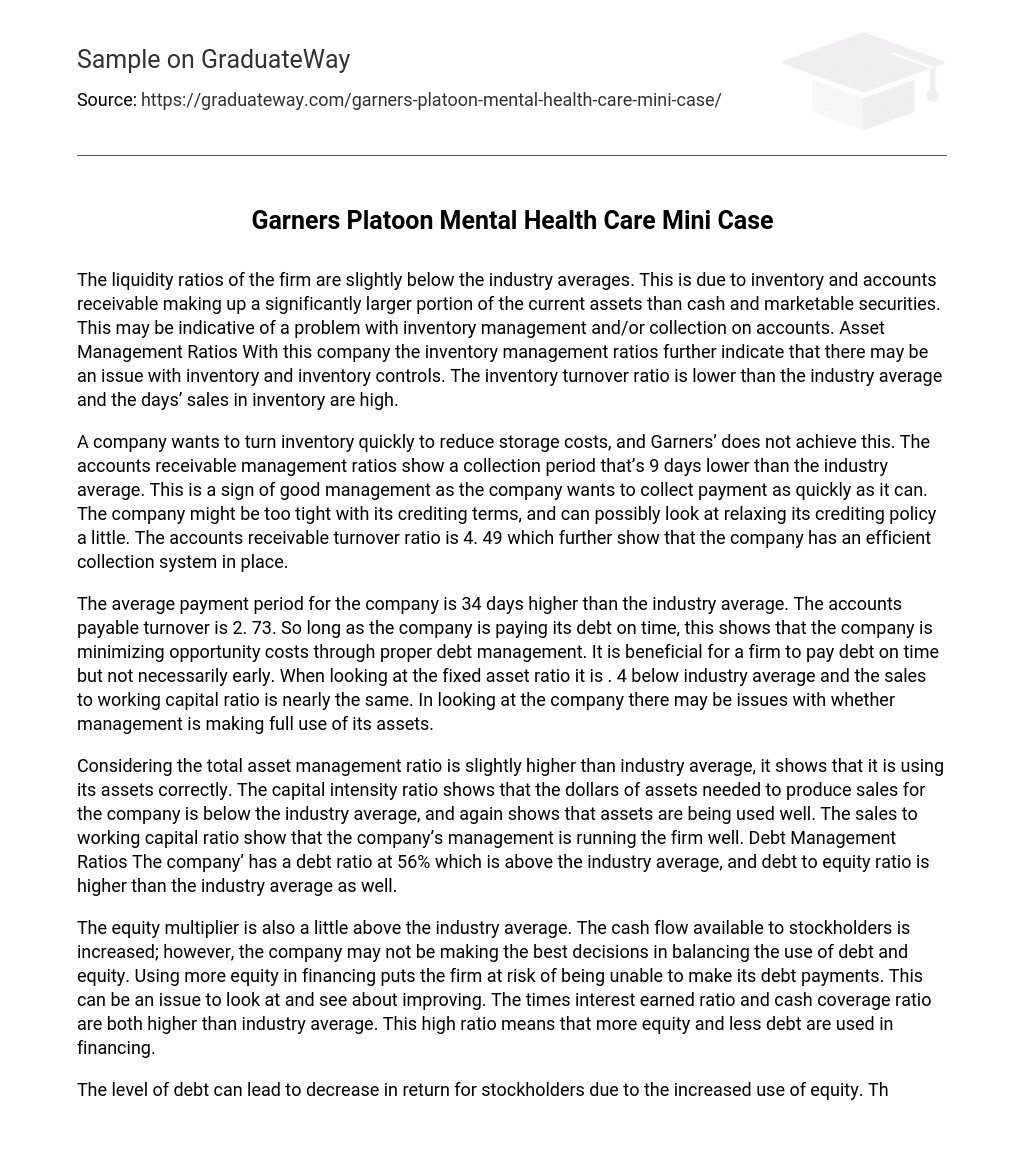The firm’s liquidity ratios are slightly below the industry averages. This is because inventory and accounts receivable make up a larger portion of the current assets compared to cash and marketable securities. This suggests a possible problem with inventory management and/or collection on accounts.
Regarding the asset management ratios, the inventory management ratios also indicate a potential issue with inventory and inventory controls within the company. The inventory turnover ratio is lower than the industry average, and the days’ sales in inventory are high.
The company aims to minimize storage costs by swiftly selling inventory, but Garners’ is unable to accomplish this. The accounts receivable management ratios demonstrate a collection period that is 9 days below the industry norm, indicating effective management. This suggests that the company strives to obtain payment promptly. It is possible that the company has overly strict credit terms and could consider loosening its credit policy slightly. Additionally, the accounts receivable turnover ratio stands at 4.49, indicating the presence of an efficient collection system in the company.
The company’s average payment period is 34 days higher than the industry average. However, the accounts payable turnover is 2.73, indicating that the company is paying its debt on time and effectively managing its debt to minimize opportunity costs. It is advantageous for a firm to pay debt on time, rather than early. Moreover, the fixed asset ratio is 0.4 below the industry average, suggesting potential issues with asset utilization by management. Similarly, the sales to working capital ratio is almost the same as the industry average. These factors raise concerns about whether the company’s management is fully utilizing its assets.
The company’s total asset management ratio is slightly higher than the industry average, indicating proper utilization of assets. Additionally, the capital intensity ratio suggests that the company requires fewer assets than the industry average to generate sales, further demonstrating efficient asset management. The sales to working capital ratio implies effective management by the company’s leadership team. However, the company’s debt ratio is 56%, surpassing the industry average, and the debt to equity ratio also exceeds the industry average.
The equity multiplier is slightly above the industry average, which increases the cash flow available to stockholders. However, the company may not be making optimal decisions in balancing debt and equity usage. Having a higher proportion of equity in financing exposes the firm to the risk of being unable to meet its debt payments. This is an area for improvement. Both the times interest earned ratio and cash coverage ratio exceed the industry average, indicating a greater reliance on equity and less on debt for financing.
The level of debt can result in a decrease in stockholders’ return as a result of higher equity utilization. The Company may need to consider increasing its short-term and potentially long-term debt. Profitability ratios indicate that the company is earning profit better than the industry, with a profit margin and basic earnings power ratio exceeding the industry average by more than 6%. Furthermore, both the ROA and ROE demonstrate a healthy profit margin for the company. The dividend payout also indicates that the company is outperforming industry expectations.
Analysis of the company suggests that it is profitable but not very efficient, carrying some level of risk. Market value ratios indicate that the company performs at a similar level to the industry, which is good but could be improved with better financial efficiency. Garners Platoon Mental Health Care Inc. was analyzed using the DuPont analysis method. The results include a 27% profit margin, indicating operating efficiency. The asset turnover is 0.55 times, showcasing asset utilization efficiency. The equity multiplier is 2.26, reflecting the financial leverage of the firm. These results are comparable to traditional ratios: a 25.44% profit margin (compared to a 27% DuPont), a 0.54 asset turnover (compared to a 0.55 DuPont), and a 2.28 equity multiplier (compared to a 2.26 DuPont), all of which outperform the industry averages of 18.75%, 0.50, and 2 times, respectively.
The results reveal that the utilization of DuPont analysis, with ROE as the primary indicator, yields ratios that closely resemble the regular ones. Moreover, the traditional ratio’s ROE stands at 31.32%, while the DuPont ratio reaches 33.10%. This is significantly higher than the industry average of 18.75%, proving the robustness of the firm’s ROE. Although the company faces challenges concerning liquidity, inventory management, and debt management, it still manages to perform well for its shareholders. Nevertheless, there is room for improvement in catering to the stockholders’ interests, and addressing the aforementioned issues is necessary.





